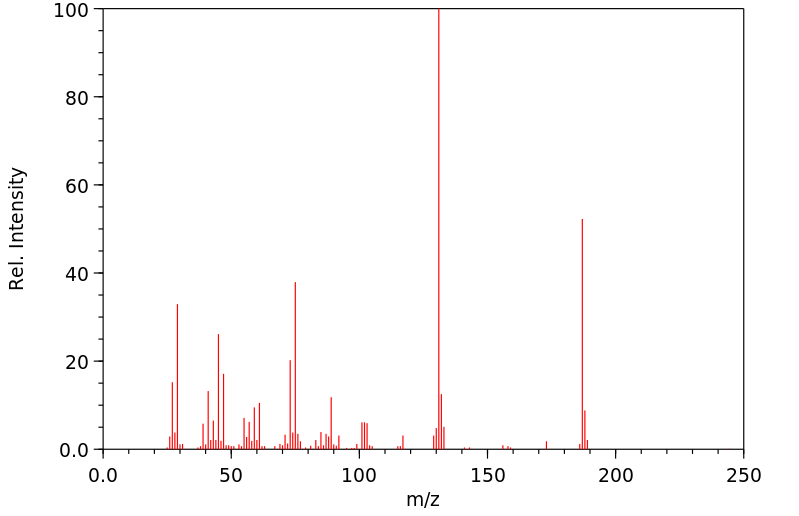ethoxy-tributyl-silane | 4782-00-7
中文名称
——
中文别名
——
英文名称
ethoxy-tributyl-silane
英文别名
ethoxy(tri-n-butyl)silane;Aethoxy-tributyl-silan;Tributyl(ethoxy) silane;tributyl(ethoxy)silane
CAS
4782-00-7
化学式
C14H32OSi
mdl
——
分子量
244.493
InChiKey
ZQJYXISBATZORI-UHFFFAOYSA-N
BEILSTEIN
——
EINECS
——
-
物化性质
-
计算性质
-
ADMET
-
安全信息
-
SDS
-
制备方法与用途
-
上下游信息
-
文献信息
-
表征谱图
-
同类化合物
-
相关功能分类
-
相关结构分类
物化性质
-
保留指数:1337
计算性质
-
辛醇/水分配系数(LogP):5.37
-
重原子数:16
-
可旋转键数:11
-
环数:0.0
-
sp3杂化的碳原子比例:1.0
-
拓扑面积:9.2
-
氢给体数:0
-
氢受体数:1
上下游信息
-
上游原料
中文名称 英文名称 CAS号 化学式 分子量 三丁基(甲氧基)硅烷 Tributylmethoxysilane 15811-64-0 C13H30OSi 230.466 -
下游产品
中文名称 英文名称 CAS号 化学式 分子量 三丁基(甲氧基)硅烷 Tributylmethoxysilane 15811-64-0 C13H30OSi 230.466
反应信息
-
作为反应物:描述:参考文献:名称:格洛纳德IVB级分类法 练习曲杜mécanisme倾DES导出德拉印版ř ñ SiΣ 4- Ñ摘要:在温度> 100°时,叔丁基氯化镁将R 3SiΣ型三有机硅烷(ΣCl或OCH 3)转化为氢硅烷R 3 SiH的过程同时进行两个过程:有机镁化合物的直接还原和间接的格氏试剂的热分解导致氢化镁还原。这些结果可以推广到各种空间受阻的格氏试剂的还原作用:R = C 6 H 11,C 5 H 9,iC 3 H 7。DOI:10.1016/s0022-328x(00)86243-9
-
作为产物:描述:参考文献:名称:格洛纳德IVB级分类法 练习曲杜mécanisme倾DES导出德拉印版ř ñ SiΣ 4- Ñ摘要:在温度> 100°时,叔丁基氯化镁将R 3SiΣ型三有机硅烷(ΣCl或OCH 3)转化为氢硅烷R 3 SiH的过程同时进行两个过程:有机镁化合物的直接还原和间接的格氏试剂的热分解导致氢化镁还原。这些结果可以推广到各种空间受阻的格氏试剂的还原作用:R = C 6 H 11,C 5 H 9,iC 3 H 7。DOI:10.1016/s0022-328x(00)86243-9
文献信息
-
Convenient route to di- and triorganosilyl ethyl ethers and the corresponding di- and triorganosilanes作者:James M. Tour、Jens A. John、Erie B. StephensDOI:10.1016/0022-328x(92)83181-g日期:1992.5alkyl- and aryllithium reagents for the preparation of organosilyl ethyl ethers of the type R3SiOEt, R2R′SiOEt, and R2Si(OEt)2, that can be reduced to the organosilanes R3SiH, R2R′SiH, and R2SiH2, respectively. Compounds of the type RR′R′SiOEt cannot be cleanly formed. The reduction procedure involves treatment of the silyl alkoxy ethers with diisobutylaluminium hydride (DIBALH) and hydrolysis of the remaining
-
Stepwise on-demand functionalization of multihydrosilanes enabled by a hydrogen-atom-transfer photocatalyst based on eosin Y作者:Xuanzi Fan、Muliang Zhang、Yuanjun Gao、Qi Zhou、Yanbin Zhang、Jiajia Yu、Wengang Xu、Jianming Yan、Haiwang Liu、Zhexuan Lei、Yan Chong Ter、Supphachok Chanmungkalakul、Yanwei Lum、Xiaogang Liu、Ganglong Cui、Jie WuDOI:10.1038/s41557-023-01155-8日期:——we show that using it as a direct HAT photocatalyst enables the stepwise custom functionalization of multihydrosilanes, giving access to fully substituted silicon compounds. By exploiting this strategy, we realize preferable hydrogen abstraction of Si–H bonds in the presence of active C–H bonds, diverse functionalization of hydrosilanes (for example, alkylation, vinylation, allylation, arylation, deuteration有机硅烷对现代人类社会至关重要,在功能材料、有机合成、药物发现和生命科学等领域有着广泛的应用。然而,它们的制备远非微不足道,杂配取代硅试剂的按需合成是一项艰巨的挑战。通过直接氢原子转移 (HAT) 光催化从氢硅烷中产生甲硅烷基代表了氢硅烷活化的原子、步骤、氧化还原和催化剂最经济的途径。在这里,鉴于中性伊红 Y 的绿色特性(例如其丰富、低成本、无金属、吸收可见光和出色的选择性),我们表明将其用作直接 HAT 光催化剂可以实现逐步定制功能化多氢硅烷,获得完全取代的硅化合物。通过利用这一策略,我们实现了在活性 C-H 键存在下优选的 Si-H 键夺氢、氢硅烷的多样化功能化(例如,烷基化、乙烯基化、烯丙基化、芳基化、氘化、氧化和卤化),并且显着二氢硅烷和三氢硅烷的选择性单官能化。
-
Malignant Peripheral Nerve Sheath Tumors with t(X;18). A Pathologic and Molecular Genetic Study作者:Maureen J O'Sullivan、Michael Kyriakos、Xiaopei Zhu、Mark R Wick、Paul E Swanson、Louis P Dehner、Paul A Humphrey、John D PfeiferDOI:10.1038/modpathol.3880230日期:2000.11Spindle cell sarcomas often present the surgical pathologist with a considerable diagnostic challenge. Malignant peripheral nerve sheath tumor, leiomyosarcoma, fibrosarcoma, and monophasic synovial sarcoma may all appear similar histologically. The application of ancillary diagnostic modalities, such as immunohistochemistry and electron microscopy, may be helpful in the differentiation of these tumors, but in cases in which these adjunctive: techniques fail to demonstrate any more definitive evidence of differentiation, tumor categorization may remain difficult. Cytogenetic and molecular genetic characterization of tumors have provided the basis for the application of molecular assays as the newest components of the diagnostic armamentarium. Because the chromosomal translocation t(X;18) has been observed repeatedly in many synovial sarcomas, it has been heralded as a diagnostic hallmark of synovial sarcoma To formally test the specificity of this translocation for the diagnosis of synovial sarcoma, RNA extracted from formalin-fixed, parrafin-embedded tissue from a variety of soft tissue and spindle cell tumors was evaluated fbr the presence of t(X;18) by reverse transcriptase-polymerase chain reaction. Although 85% of the synovial sarcomas studied demonstrated t(X;18), 75% of the malignant peripheral nerve sheath tumors in our cohort also demonstrated this translocation. We conclude that the translocation t(X;18) is not specific to synovial sarcoma and discuss the implications of the demonstration of t(X;18) in a majority of malignant peripheral nerve sheath tumors.
-
Petrow; Schtschukowskaja, Zhurnal Obshchei Khimii, 1955, vol. 25, p. 1128,1134;engl.Ausg.S.1083,1087作者:Petrow、SchtschukowskajaDOI:——日期:——
-
Preparation of Organofluorosilanes Using Aqueous Hydrofluoric Acid<sup>1</sup>作者:N. S. Marans、L. H. Sommer、F. C. WhitmoreDOI:10.1021/ja01155a033日期:1951.11
表征谱图
-
氢谱1HNMR
-
质谱MS
-
碳谱13CNMR
-
红外IR
-
拉曼Raman
-
峰位数据
-
峰位匹配
-
表征信息
同类化合物
(2-溴乙氧基)-特丁基二甲基硅烷
鲸蜡基聚二甲基硅氧烷
骨化醇杂质DCP
马沙骨化醇中间体
马来酸双(三甲硅烷)酯
顺式-二氯二(二甲基硒醚)铂(II)
顺-N-(1-(2-乙氧基乙基)-3-甲基-4-哌啶基)-N-苯基苯酰胺
降钙素杂质13
降冰片烯基乙基三甲氧基硅烷
降冰片烯基乙基-POSS
间-氨基苯基三甲氧基硅烷
镓,二(1,1-二甲基乙基)甲基-
镁,氯[[二甲基(1-甲基乙氧基)甲硅烷基]甲基]-
锑,二溴三丁基-
铷,[三(三甲基甲硅烷基)甲基]-
铂(0)-1,3-二乙烯-1,1,3,3-四甲基二硅氧烷
钾(4-{[二甲基(2-甲基-2-丙基)硅烷基]氧基}-1-丁炔-1-基)(三氟)硼酸酯(1-)
金刚烷基乙基三氯硅烷
酰氧基丙基双封头
达格列净杂质
辛醛,8-[[(1,1-二甲基乙基)二甲基甲硅烷基]氧代]-
辛甲基-1,4-二氧杂-2,3,5,6-四硅杂环己烷
辛基铵甲烷砷酸盐
辛基衍生化硅胶(C8)ZORBAX?LP100/40C8
辛基硅三醇
辛基甲基二乙氧基硅烷
辛基三甲氧基硅烷
辛基三氯硅烷
辛基(三苯基)硅烷
辛乙基三硅氧烷
路易氏剂-3
路易氏剂-2
路易士剂
试剂Cyanomethyl[3-(trimethoxysilyl)propyl]trithiocarbonate
试剂3-[Tris(trimethylsiloxy)silyl]propylvinylcarbamate
试剂3-(Trimethoxysilyl)propylvinylcarbamate
试剂2-(Trimethylsilyl)cyclopent-2-en-1-one
试剂11-Azidoundecyltriethoxysilane
西甲硅油杂质14
衣康酸二(三甲基硅基)酯
苯胺,4-[2-(三乙氧基甲硅烷基)乙基]-
苯磺酸,羟基-,盐,单钠聚合甲醛,1,3,5-三嗪-2,4,6-三胺和脲
苯甲醇,a-[(三苯代甲硅烷基)甲基]-
苯并磷杂硅杂英,5,10-二氢-10,10-二甲基-5-苯基-
苯基二甲基氯硅烷
苯基二甲基乙氧基硅
苯基二甲基(2'-甲氧基乙氧基)硅烷
苯基乙酰氧基三甲基硅烷
苯基三辛基硅烷
苯基三甲氧基硅烷







